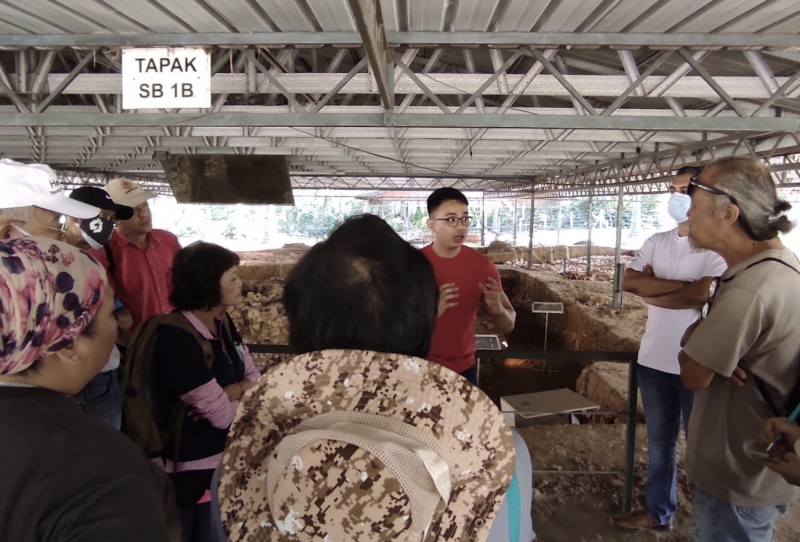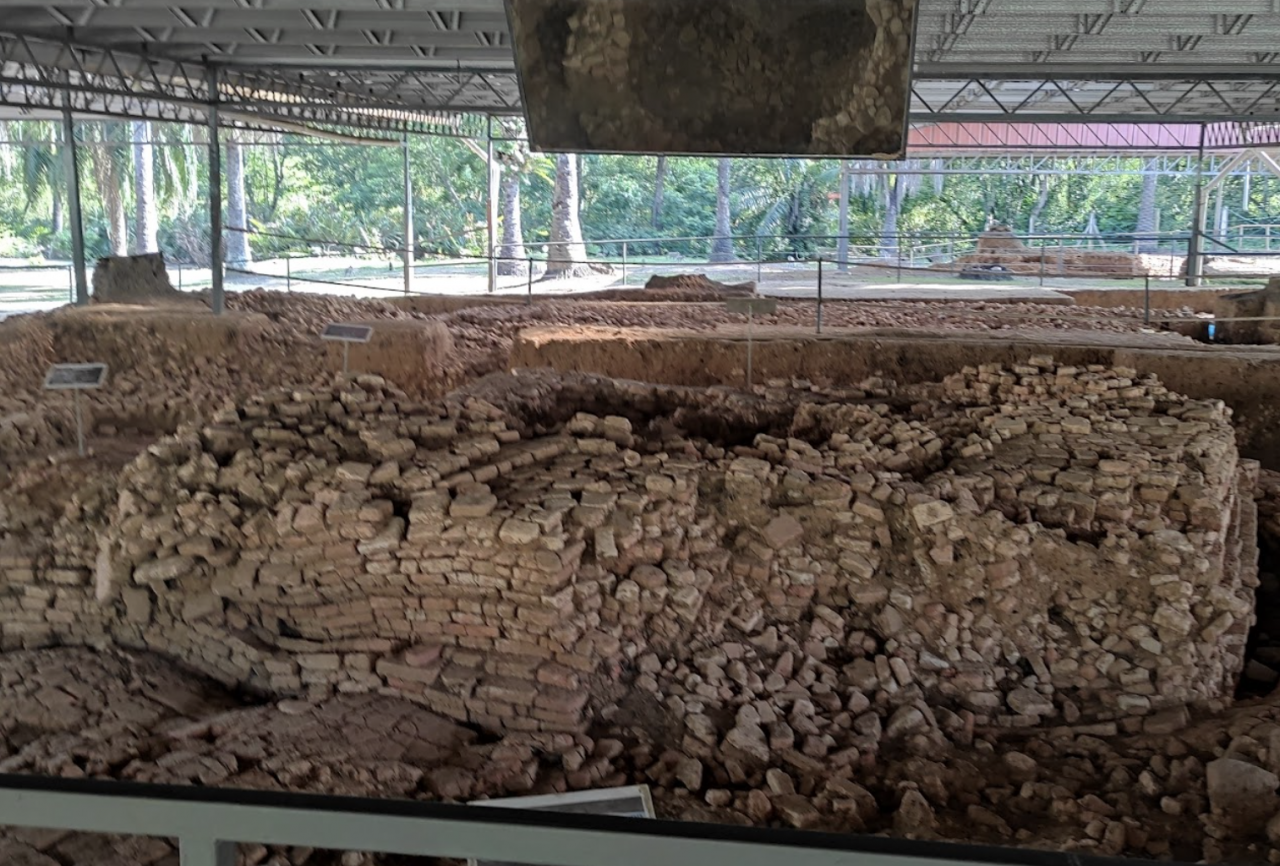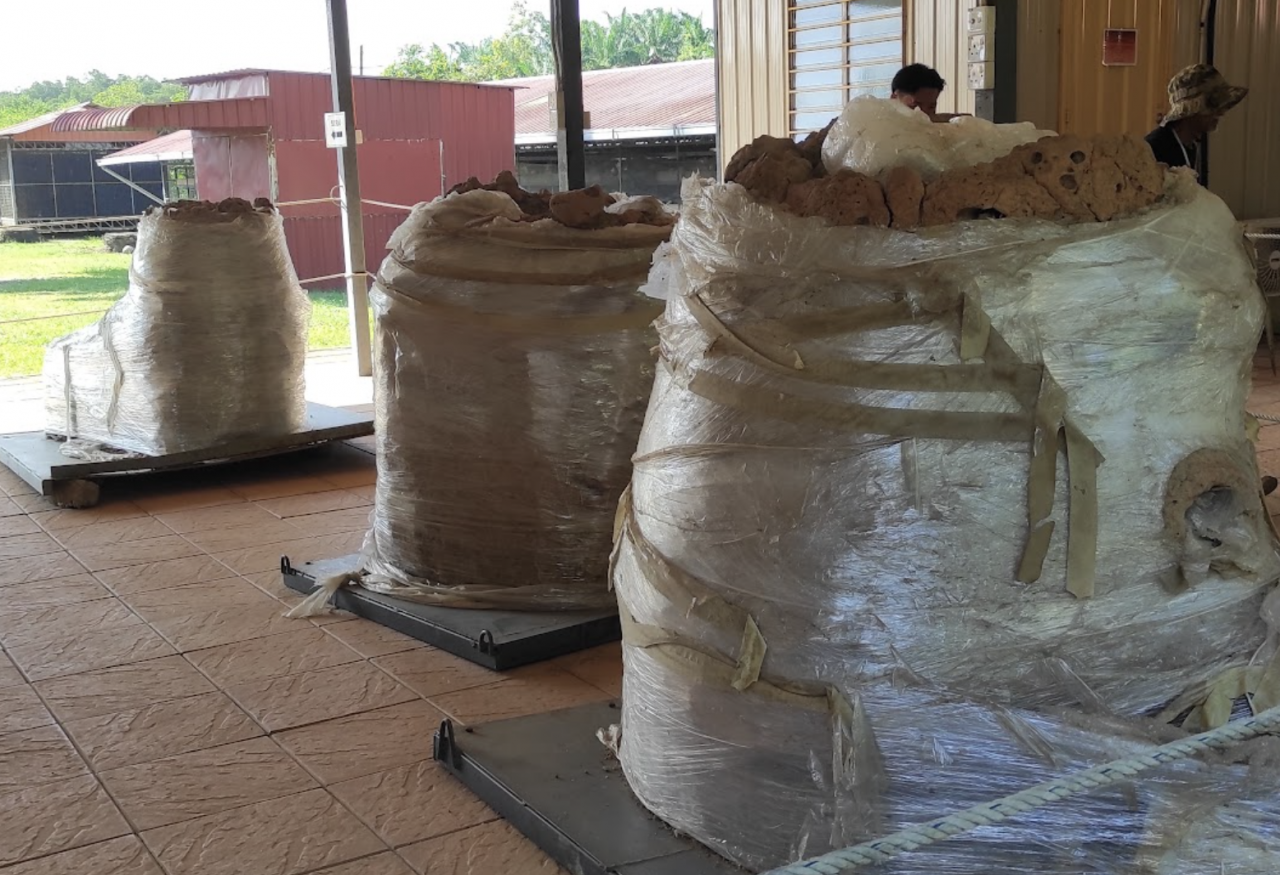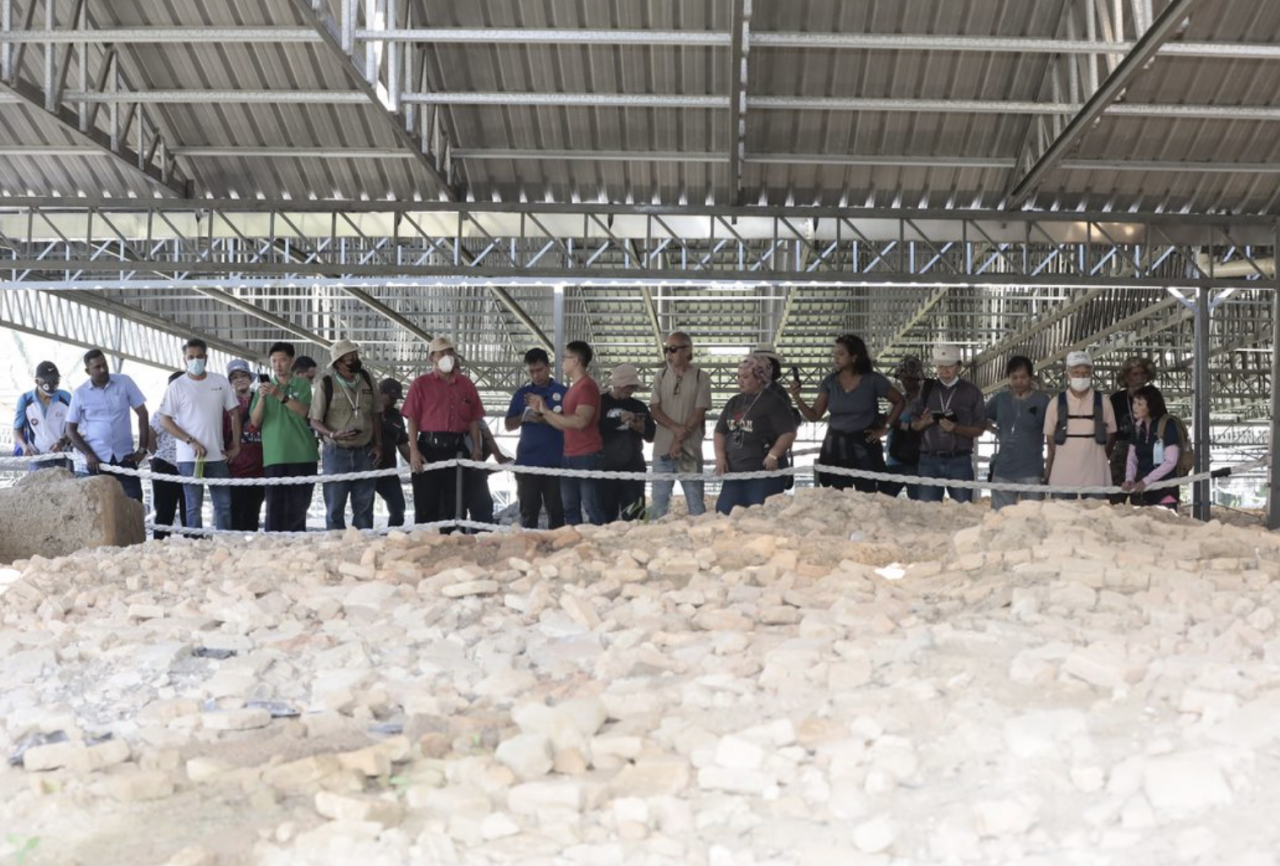ONLINE NEWS: BUJANG VALLEY: REVISED DATING, NARRATIVE TOWARDS UNESCO LISTING OF ANCIENT KEDAH
The Vibe
Bujang Valley: revised dating, narrative towards Unesco listing of ancient maritime site
Archaeologist says diversity, multiculturalism among key lessons from Ancient Kedah
By Maria J. Dass | 06 Jul 2023

Speaking at a training programme for content creators and travel agents held in early June, Nasha Rodziadi Khaw (centre) says the earlier sample dated between 788 BC an 537 BC is for now deemed to be an ‘outlier’ – unless more evidence of samples with the same dating are found. – Pic courtesy of USM Centre for Global Archeological Research, July 6, 2023
KUALA LUMPUR – A recent news report by a regional television station has reignited debate on the progress involving archeological findings in Ancient Kedah.
Questions are being raised on the development of the Bujang Valley as a heritage site that encompasses what was once a large iron smelting industry, and a thriving port city that hosted a multi-cultural and multi-religious society.
The report, which claimed that progress and development at the site had stalled, caught Universiti Sains Malaysia’s (USM) Centre for Global Archeological Research (CGAR) researchers, currently working on the historical site, by surprise.
Post-pandemic, the team has been busy re-examining past narratives and findings, ahead of moves to list Bujang Valley or Lembah Bujang, as a United Nations Educational Scientific and Cultural Organisation (Unesco) World Heritage Site (WHS).
This includes narratives based on findings supported by more current data analysis techniques endorsed by peer reviews, coupled with supporting written records and ancient texts.
USM CGAR senior lecturer and archaeologist Nasha Rodziadi Khaw said recent findings – based on analysis of available data – indicate that the iron smelting site in Sg Batu may not be as old as it was previously thought to be.
It was earlier reported to date back to 788 BC.
The Bayesian Chronological Modelling online application used in 2019 to analyse radiocarbon data via a two-dimensional model – which gives a detailed analysis of a site – showed that a majority of samples collected from the Sg Batu iron smelting site were dated between 2nd and 10th century AD.
These were consistent with the tangible cultural structures, written historical accounts and have been endorsed by peer reviews.

A total of 97 archeological sites have been discovered in the Bujang Valley, of which 54 have been excavated. There are, however, many candi and temples located in the forest that have yet to be discovered or excavated. – Pic courtesy of USM Centre for Global Archeological Research, July 6, 2023
Dynamic research
Speaking at a training programme for content creators and travel agents held in early June, Nasha said the earlier sample dated between 788 BC an 537 BC is for now deemed to be an “outlier” – unless more evidence of samples with the same dating are found.
“We may find more samples in the future to prove that Sg Batu existed in 788 BC, but for now the findings are insufficient to stand against evidence that points to the existence of that civilisation between 2nd and 10th century AD,” he said.
He added that research is dynamic, and changes all the time with new findings which we need to keep up with.
The training programme in early June was aimed at addressing misconceptions, presenting updated narratives, interpretation, and new data based on recent findings.
It was also aimed at building a strong network between travel agents and content creators to facilitate exchange of knowledge and academic discussions towards boosting interest in cultural heritage.
The programme supported by ThinkCity Sdn Bhd was also aimed at linking heritage sites all over the country, creating positive visitor experiences at these sites and boosting opportunities for small and medium enterprises in these areas.
Outstanding universal value
Nasha said that while the new dating might seem a little less impressive as compared to the previous one, there is no point in arguing whether the Malay peninsula was home to the greatest kingdoms or the oldest kingdoms in ancient times.
"What we know for sure is that Ancient Kedah was a maritime society built on multiculturalism, respect and acceptance of foreign ideas, knowledge, technologies and innovations – (all of) which is relevant to us even today as we move forward as a nation,” he said.
He said that this was the outstanding universal value (OUV) that the USM CGAR opines makes Ancient Kedah unique.
Bujang Valley was a part of Ancient Kedah which is believed to have spanned the entire west coast of Peninsular Malaysia, while Sg Batu located within the valley was the site of a large iron smelting industry and port city through which iron ingots were exported.
Geophysical studies show that the sea was closer to Gunung Jerai, a beacon for sailors entering the Straits of Melaka, but a drop in sea levels caused the shoreline to move further west making the river leading to a bay that was the port shallow, and thus inaccessible to ships in later years.
USM CGAR is currently working closely with the National Heritage Department to list Ancient Kedah as a Unesco World Heritage Site.
Nasha said: “We are moving towards this listing which has to start with a dossier that clearly states the OUV for the site, hence we need to ensure that our findings are up to date and on par with international standards.”

The Bayesian Chronological Modelling online application used in 2019 to analyse radiocarbon data via a two-dimensional model – which gives a detailed analysis of a site – showed that a majority of samples collected from the Sg Batu iron smelting site were dated between 2nd and 10th century AD. These were consistent with the tangible cultural structures, written historical accounts and have been endorsed by peer reviews. – Pic courtesy of USM Centre for Global Archeological Research, July 6, 2023
Little done for historical park plan
“In addition to that, we have to address some obstacles – namely land development issues. It is imperative for sites to adhere to and uphold the OUVs as any threat or reversal of value might result in being delisted as a WHS,” he said.
A technical report published by Unesco in 1987 stated that although the federal government of Malaysia made a proposal for establishing a national historical park in the Bujang Valley as far back as 1968-1989, as a start to their programme for developing a cultural heritage policy, little has been done to bring this proposal to realisation.
The report made recommendations for both short- and long-term situations.
The long-term objectives were:
- For the Bujang Valley: to establish a National Historical Park within the Bujang Valley with a view to protecting, preserving and presenting the archaeological sites found therein and thereby creating a national and international tourist destination; and
- For the Kuala Kedah Fort: to undertake the excavation, conservation and presentation of the Kuala Kedah Fort as a national and international tourist destination.
The short-term objectives were:
- to prepare a master plan for the excavation, conservation and presentation of the monuments of the Bujang Valley National Historical Park and the Kuala Kedah Fort;
- to augment and train professional staff in the present Bujang Valley Museum;
- to expand the existing museum and visitor facilities at the Bujang Valley Museum complex;
- to develop suitable museum and visitor facilities at the Kuala Kedah Fort.

While human remains or a burial site may hold answers to the type of people or society that inhabited Ancient Kedah, this was a highly unlikely discovery, as human remains rarely survive the hot and humid tropical weather, says Nasha Rodziadi Khaw. – Pic courtesy of USM Centre for Global Archeological Research, July 6, 2023
Narratives
The three common narratives when interpreting heritage sites and ancient civilisations are:
- The official narrative: the narrative that the government or administrators of the day would like to further;
- The popular narrative: the version of the story that appeals to a wider audience because of the romanticised appeal it affords a person or place; and
- The scholarly narrative: one that is based on years of data collection, evidence, peer-reviews and comparative studies.
The most accurate of these is the scholarly narrative, bearing in mind that this may change over time as research is dynamic, and any new discoveries might shift the facts in a different direction altogether, Nasha said.
The key lessons we can learn from Ancient Kedah are the narrative of a tolerant, diversified and multicultural maritime civilisation, he opined.
Nasha added that these were qualities that set it apart from other more monocultural civilisations in the region.
What the future holds
A total of 97 archeological sites have been discovered in the Bujang Valley, of which 54 have been excavated.
There are, however, many candi and temples located in the forest that have yet to be discovered or excavated.
Findings that suggest the existence of about seven ancient boats buried in the swamp in Sg Batu have also not been conclusive.
“The cost of verifying this can reach up to RM20 to 30 million – just to excavate the ships – which we aren’t sure are there in the first place.
“We have to ensure that the money we have is spent prudently on more conclusive findings instead of being wasted on things we are not sure of,” he added.
There are no likely conclusions to the bigger story behind Ancient Kedah yet, due to the simple fact that the archeological sites of this ancient civilisation are still active archeological sites.
“We may not find all the answers in our lifetime as there is so much more to be discovered out there,” Nasha said.
While human remains or a burial site may hold answers to the type of people or society that inhabited Ancient Kedah, this was a highly unlikely discovery, as human remains rarely survive the hot and humid tropical weather, he added.
In addition to this, a society that practised Hinduism and Buddhism probably cremated their dead instead of burying them, Nasha said. – The Vibes, July 6, 2023
- Created on .
- Hits: 927
